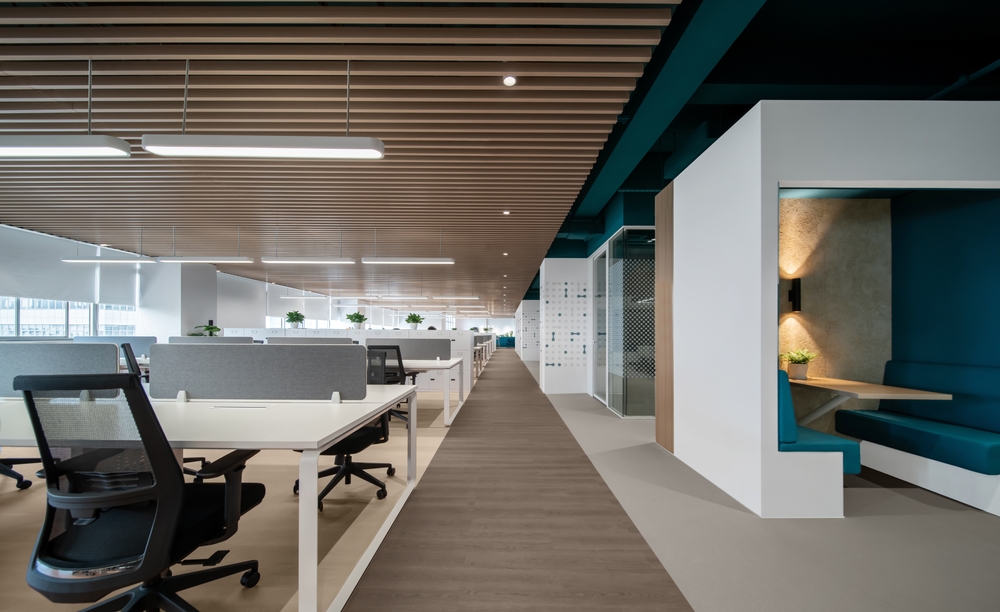
How to find commercial office space for rent
Finding the right commercial office space is a pivotal decision for any business, whether you’re a burgeoning startup or an established company looking to expand. The process can seem daunting, especially if you’re unfamiliar with the intricacies of commercial real estate. However, by understanding the need for office space and gaining an overview of the leasing process, you can approach this task with confidence and clarity.
In this story
Understanding the Need for Office Space
The first step in finding the perfect office space is to clearly define why you need it. This involves a thorough assessment of your business’s operational requirements and strategic goals. Consider the nature of your business: Do you need space for a collaborative team environment, or are you seeking a quiet area for focused work? Additionally, think about the image you want to project to clients and partners. A tech startup might seek a modern, open-concept space to foster creativity, while a law firm might prefer a more traditional setting that conveys professionalism.
Understanding these needs helps in identifying the type of office environment that will best support your business activities and culture. It’s also crucial to consider future growth plans. If expansion is on the horizon, look for spaces that offer flexibility, such as scalable layouts or short-term leasing options. This foresight can save you time and money in the long run, preventing the need for another move as your business evolves.
Overview of the Leasing Process
Once you have a clear understanding of your needs, it’s essential to familiarize yourself with the leasing process. This knowledge will empower you to navigate the market effectively and make informed decisions. The leasing process typically begins with researching available properties, either through online platforms or by engaging a commercial real estate agent. These professionals can provide valuable insights into market trends and help identify properties that align with your criteria.
As you begin to shortlist potential spaces, it’s important to schedule site visits to evaluate each location firsthand. During these visits, assess the amenities, layout, and overall condition of the space. Pay attention to the surrounding area, considering factors such as accessibility, parking, and proximity to key clients or partners.
After selecting a preferred location, you’ll enter the negotiation phase. This involves discussing lease terms with the landlord, which may include rent, lease duration, and any tenant improvement allowances. Understanding different types of leases—such as full-service leases, net leases, or modified gross leases—will aid in these negotiations. Each type has its own cost structure and responsibilities, so choose one that best suits your financial and operational needs.
Finally, once terms are agreed upon, review the lease agreement carefully before signing. It’s advisable to consult with a legal professional to ensure all clauses align with your business interests and protect you from potential liabilities. By following these steps, you can secure a commercial office space that meets your needs and supports your business’s growth.
Determining Space Requirements

Selecting the right commercial office space begins with a comprehensive understanding of your space requirements. This involves assessing your business needs, calculating the necessary square footage, and considering future growth. Each step is crucial to ensure the space not only meets your current demands but also accommodates potential expansion.
Assessing Business Needs
The first step in determining space requirements is a thorough assessment of your business’s operational needs. Start by evaluating the number of employees and the nature of their work. Different departments may have varying spatial needs. For instance, a sales team might require a dynamic, open-plan environment to facilitate communication, while the accounting department might benefit from quieter, more private workstations to ensure focus and confidentiality.
Consider the types of spaces your business uses regularly, such as meeting rooms, breakout areas, or dedicated spaces for specialized equipment. A technology firm may need server rooms, whereas a creative agency might prioritize design studios. Understanding these specific needs ensures that the office space supports your business operations effectively.
Calculating Square Footage
Once you have a clear picture of your business needs, the next step is calculating the necessary square footage. A general rule of thumb is to allocate about 150 to 250 square feet per employee, depending on the level of comfort and the type of work they perform. However, this is a baseline figure and should be adjusted based on your specific business requirements and the layout of the potential office space.
In addition to individual workspaces, include communal areas such as conference rooms, kitchens, and restrooms in your calculations. Also, consider any storage needs for supplies, inventory, or equipment. Having a comprehensive understanding of your square footage requirements will help you avoid spaces that are too cramped or excessively large, both of which can lead to inefficiencies and unnecessary costs.
Future Growth Considerations
Finally, it’s essential to factor in future growth when determining your space requirements. If you anticipate hiring additional staff or expanding your services, choose a space that can adapt to these changes. This might mean opting for an office with flexible floor plans or one that allows for easy reconfiguration.
Consider lease options that offer scalability, such as short-term leases or those with expansion clauses, which allow you to adjust your space as your business evolves. An office space that can grow with your company will save you the hassle and expense of relocating in the near future.
By thoroughly assessing your business needs, accurately calculating square footage, and planning for future growth, you can find a commercial office space that aligns with your current operations and supports your long-term objectives.
Budgeting for Office Space

One of the most critical steps in securing commercial office space is establishing a clear budget. This involves not only setting a realistic budget for rent but also understanding the additional costs that may arise and ensuring comprehensive financial planning. A well-thought-out budget will guide your search and prevent financial strain, allowing you to focus on finding a space that meets your business needs.
Setting a Realistic Budget
The foundation of any successful office space search lies in setting a realistic budget. Begin by assessing your company’s financial health and determining how much you can allocate to office rent without compromising other operational expenses. Typically, commercial real estate experts suggest that rent should account for no more than 10% of your gross revenue, but this can vary depending on industry standards and your specific financial situation.
Consider the location of the office space, as rent prices can vary significantly based on the area. Prime locations often come at a premium, so weigh the benefits of a prestigious address against the cost. It’s important to remain flexible and open to different neighborhoods or buildings that might offer better value for your budget.
Understanding Additional Costs
In addition to the base rent, there are several ancillary costs associated with leasing office space that must be accounted for in your budget. These can include utilities, maintenance fees, property taxes, and insurance. Some leases may require you to cover a portion of the building’s operating expenses, known as Common Area Maintenance (CAM) charges.
Moreover, consider the cost of furnishing the space and any necessary renovations or improvements to tailor the office to your business needs. These can add up quickly, so it’s crucial to factor them into your financial planning from the outset.
Financial Planning
Effective financial planning is essential to ensure that your office space remains a sustainable investment over time. Start by creating a detailed budget that includes all anticipated costs, both fixed and variable, and plan for potential fluctuations in expenses. This foresight will help you manage cash flow and avoid unexpected financial burdens.
It’s also wise to set aside a contingency fund for unforeseen expenses, such as emergency repairs or sudden increases in utility costs. Regularly reviewing your budget and financial projections can help you stay on track and make informed decisions if adjustments are needed.
Additionally, consider consulting with a financial advisor or real estate professional who can provide insights into market trends and help you optimize your office space investment. By setting a realistic budget, understanding additional costs, and engaging in thorough financial planning, you can find an office space that aligns with your business’s financial goals and supports long-term success.
Choosing the Right Location

Selecting the right location for your commercial office space is a decision that can significantly impact your business’s success. The location not only influences your brand image but also affects your operational efficiency and employee satisfaction. When choosing a location, it’s crucial to evaluate proximity to clients and employees, consider accessibility and transportation options, and examine local market trends to ensure that your choice aligns with your business objectives.
Evaluating Proximity to Clients and Employees
A prime consideration when choosing an office location is its proximity to both clients and employees. Being close to your clients can enhance business relationships and facilitate easier face-to-face meetings, which are often more productive and effective than virtual interactions. If your business relies heavily on client visits, a centrally located office in a prestigious area can also strengthen your brand’s image and credibility.
Similarly, consider the daily commute for your employees. An office situated in a convenient location can lead to higher job satisfaction, reduce turnover rates, and improve overall productivity. Evaluate where the majority of your workforce resides and look for locations that offer a reasonable commute. This consideration is especially vital in metropolitan areas where traffic congestion can be a significant factor.
Accessibility and Transportation
Accessibility and transportation options are fundamental elements of choosing an office location. Ensure the location is easily accessible for both employees and clients, with ample public transportation options such as buses, trains, or subways. Proximity to major highways or airports is also a plus, especially if your business involves frequent travel.
Consider the availability of parking facilities for those who drive. Adequate parking can be a deciding factor for employees and clients who prefer driving to public transit. Additionally, assess the neighborhood’s walkability, including nearby amenities like restaurants, banks, and fitness centers, which can enhance the work-life balance for your team.
Examining Local Market Trends
Understanding local market trends is crucial when selecting an office location. Conducting a thorough market analysis will provide insights into the economic health of the area, rental trends, and the availability of commercial spaces. A location within a growing business district can offer networking opportunities and access to a talent pool, but might also come with higher rental costs.
Investigate future developments planned for the area, such as infrastructure projects or new business complexes, which could affect the desirability and value of your chosen location. Consulting with a real estate professional can help you interpret these trends and make a well-informed decision.
By evaluating proximity to clients and employees, ensuring accessibility and transportation convenience, and examining local market trends, you can select an office location that enhances your business operations and supports long-term success.
Exploring Lease Types

When searching for commercial office space, understanding the various lease types available is crucial to making an informed decision that aligns with your business needs. Each lease structure comes with its own set of terms and flexibility, impacting your financial commitments and operational flexibility. By understanding different lease structures, comparing lease terms, and assessing flexibility in leasing agreements, you can select a lease that best suits your business.
Understanding Different Lease Structures
Commercial leases come in several structures, each with distinct financial implications. The most common types include full-service leases, net leases, and modified gross leases. A full-service lease, also known as a gross lease, typically includes all operating expenses, such as utilities, maintenance, and property taxes, within the rent. This structure provides simplicity and predictability in budgeting, as you pay a single, consistent amount each month.
Net leases, on the other hand, shift some or all of the operating expenses onto the tenant. Single, double, and triple net leases refer to the extent of these costs, with triple net leases requiring the tenant to cover property taxes, insurance, and maintenance costs. Although net leases often have lower base rent, the additional expenses can fluctuate, requiring careful budget planning.
Modified gross leases offer a compromise, sharing operating expenses between tenant and landlord. Typically, the rent covers some costs, such as maintenance, while the tenant pays for utilities and other expenses separately. This structure can offer a balance between cost predictability and flexibility.
Comparing Lease Terms
Beyond understanding the structure, comparing lease terms is essential to finding an agreement that fits your business needs. Lease terms can vary widely in length, usually ranging from one to ten years. Shorter leases offer more flexibility, allowing you to relocate or renegotiate terms as your business evolves. However, they may come with higher rents or fewer incentives.
Longer leases generally provide stability and can lead to lower rent increases over time, but they require a more substantial commitment. Consider your business’s growth projections and stability when deciding on lease length. Pay attention to renewal options and rent escalation clauses, which can affect long-term costs.
Flexibility in Leasing Agreements
Flexibility in a leasing agreement can be a significant advantage, especially for businesses in dynamic industries. Look for leases that offer options such as subleasing or space expansion, which provide room for growth or adjustment as your business changes. Some landlords may offer early termination clauses, allowing you to exit the lease under certain conditions, though this may come with a penalty.
Negotiating flexible terms can also include seeking tenant improvement allowances, where the landlord contributes to customizing the space to meet your business’s specific needs. This can reduce upfront costs and allow you to create a more functional and appealing workspace.
By understanding different lease structures, comparing lease terms, and seeking flexibility in agreements, you can secure a lease that not only meets your immediate needs but also accommodates future business changes. This strategic approach ensures that your office space remains an asset rather than a burden as your company evolves.
Researching Potential Spaces

Finding the right commercial office space requires thorough research to identify options that align with your business needs and financial capabilities. This process involves utilizing online listings and resources, engaging with real estate agents, and visiting prospective locations to ensure you make an informed decision.
Online Listings and Resources
The internet is a powerful tool in the search for commercial office space, offering a wealth of listings and resources at your fingertips. Online platforms like LoopNet, CoStar, and CommercialCafe provide comprehensive databases of available properties, allowing you to filter searches by location, size, price, and amenities. These platforms often include detailed property descriptions, photos, floor plans, and even virtual tours, giving you a preliminary understanding of what each space offers.
In addition to property-specific information, online resources can provide insights into market trends, average rental rates, and neighborhood demographics, helping you evaluate if a particular area aligns with your business objectives. Utilizing these digital tools can significantly streamline your search process and broaden your pool of potential spaces.
Engaging with Real Estate Agents
While online resources are invaluable, engaging with a knowledgeable real estate agent can enhance your search by providing expert guidance and access to off-market listings. A seasoned commercial real estate agent can offer insights into market conditions, negotiate favorable lease terms, and help you navigate complex leasing processes. They possess in-depth knowledge of local markets and can provide recommendations based on your specific requirements and budget constraints.
Agents can also save you time by pre-screening properties and arranging viewings, allowing you to focus on spaces that truly meet your needs. Building a relationship with a trusted agent can provide ongoing benefits, especially if your business plans future expansions or relocations.
Visiting Prospective Locations
Once you’ve identified a shortlist of potential office spaces, visiting these locations in person is crucial. Site visits allow you to assess the space beyond what is visible online, providing a tangible sense of the layout, natural lighting, and overall ambiance. During your visit, evaluate the quality of construction, condition of facilities, and available amenities. Pay attention to details such as noise levels, security measures, and the upkeep of common areas.
It’s also important to explore the surrounding neighborhood during these visits. Consider the proximity to essential services, the availability of public transportation, and the general atmosphere of the area. Engaging with current tenants, if possible, can offer valuable insights into the building’s management and any potential issues.
By diligently researching potential spaces through online listings, leveraging the expertise of real estate agents, and conducting thorough site visits, you can confidently select an office space that supports your business’s operational needs and growth potential.
Evaluating Amenities and Features
When selecting commercial office space, evaluating the amenities and features of potential properties is essential to ensure they meet the operational needs of your business and create a conducive work environment. This involves assessing building facilities, technology and connectivity, as well as security and maintenance considerations.
Assessing Building Facilities
The facilities provided by a building can significantly impact the functionality and appeal of your office space. Start by evaluating the common areas, such as lobbies, restrooms, and break rooms, to ensure they are well-maintained and contribute positively to the overall ambiance. Consider the availability and condition of meeting rooms, which are essential for hosting clients and conducting team discussions.
Additionally, assess the presence of on-site amenities that can enhance employee satisfaction and productivity. These may include fitness centers, cafeterias, or outdoor spaces for relaxation. Parking facilities are another crucial consideration, especially if your employees or clients frequently drive to the office. Adequate, secure, and convenient parking can be a significant advantage.
Technology and Connectivity
In the modern business landscape, robust technology and connectivity infrastructure are non-negotiable. Evaluate the building’s internet connectivity options, including available service providers and the capacity for high-speed broadband. Ensure that the building supports reliable cell phone reception, as this is critical for communication and business operations.
Consider the technological infrastructure within the office space itself, such as wiring for data and power, to support your devices and equipment. The presence of smart office technology, such as automated lighting and climate control systems, can enhance energy efficiency and provide a more comfortable working environment.
Security and Maintenance
Security is paramount in safeguarding your business assets and ensuring the safety of your employees. Assess the building’s security features, including access control systems, surveillance cameras, and on-site security personnel. A well-secured building not only protects against unauthorized access but also provides peace of mind to your team.
Maintenance is another critical aspect to consider. Investigate the building’s maintenance policies and the responsiveness of property management in addressing issues. A well-maintained building reflects positively on your business and ensures that facilities are always in optimal condition. Regular maintenance of HVAC systems, elevators, and other essential services is crucial to prevent disruptions.
By thoroughly evaluating the amenities and features related to building facilities, technology and connectivity, and security and maintenance, you can select a commercial office space that supports your business operations, enhances employee satisfaction, and projects a professional image to clients and partners.
Negotiating the Lease
Negotiating the lease for your commercial office space is a critical step that can significantly influence your business’s operational flexibility and financial commitments. Effective negotiation requires strategic planning, a thorough understanding of lease clauses, and the guidance of legal professionals to ensure a favorable outcome.
Key Negotiation Strategies
Successful lease negotiation begins with preparation and strategy. Start by researching comparable properties to understand the market rates and terms, which will help you make informed decisions during negotiations. Establish clear priorities and know which terms are non-negotiable for your business, such as rent, lease duration, or tenant improvement allowances.
Approach negotiations with a collaborative mindset, aiming for a win-win situation. This involves being open to compromise and demonstrating flexibility on less critical terms to gain concessions on what matters most. Consider negotiating for clauses that offer future flexibility, such as options to renew or expand the space, which can provide stability and room for growth.
Understanding Lease Clauses
A commercial lease contains numerous clauses that outline the rights and responsibilities of both the tenant and landlord. Understanding these clauses is essential to protect your interests and avoid unforeseen costs or liabilities. Pay particular attention to clauses related to rent escalation, which dictate how and when rent will increase during the lease term. Also, examine maintenance responsibilities to clarify which party is responsible for repairs and upkeep.
Other critical clauses include those related to subleasing, which can offer flexibility if your space needs change, and termination clauses, which outline conditions under which the lease can be ended early. Ensure that all clauses are clear and that you fully understand their implications before signing the lease.
Consulting with Legal Professionals
Given the complexity of commercial leases, consulting with a legal professional is highly advisable. An attorney specializing in commercial real estate can provide valuable insights, ensuring that the lease terms are fair and that your rights are protected. They can help identify potential red flags and suggest modifications to clauses that may pose risks to your business.
Legal professionals can also assist in drafting or reviewing lease amendments that reflect negotiated terms accurately. Their expertise can prevent costly legal disputes in the future and provide peace of mind that your lease agreement serves your business’s best interests.
By employing key negotiation strategies, gaining a deep understanding of lease clauses, and consulting with legal professionals, you can effectively negotiate a lease that supports your business’s operational needs and financial goals.
Finalizing the Lease Agreement
Finalizing the lease agreement is the culmination of your search for commercial office space, marking the transition from negotiation to occupancy. This critical phase involves a meticulous review of the lease document, the formal signing of the lease, and preparing for the move to your new office space. Each step requires attention to detail to ensure a smooth transition and a favorable leasing experience.
Reviewing the Lease Document
Before signing, a thorough review of the lease document is essential to confirm that all negotiated terms are accurately reflected. Carefully examine each section, ensuring clarity on rent amounts, lease duration, and any agreed-upon concessions, such as tenant improvement allowances or free rent periods. Pay particular attention to clauses concerning maintenance responsibilities, renewal options, and any penalties for early termination.
Look for any ambiguous language or terms that may be open to interpretation, as these could lead to disputes in the future. It’s prudent to have a legal professional review the document to identify any potential issues and ensure that your interests are adequately protected. This step can prevent misunderstandings and provide peace of mind as you move forward.
Signing the Lease
Once you are satisfied with the lease document, the next step is the formal signing of the lease. This process typically involves both parties—tenant and landlord—signing multiple copies of the document. Ensure that all necessary signatures are obtained and that each party retains a fully executed copy for their records.
The signing of the lease signifies a legal and binding commitment, so it is crucial to be confident in your decision before this step. Once the lease is signed, any changes will require mutual agreement and potentially additional negotiation.
Preparing for the Move
With the lease finalized, it is time to prepare for the move to your new office space. Start by developing a detailed move-in plan, which should include timelines, responsibilities, and a checklist of tasks to complete before the move. Coordinate with the building management to arrange access for movers and confirm any building regulations or requirements related to the move.
Communicate with your team to ensure a smooth transition, addressing any logistical concerns and setting clear expectations. Plan for the installation of essential services, such as internet and phone lines, to minimize downtime and ensure business continuity.
Additionally, consider any necessary modifications or improvements to the new space, scheduling these as early as possible to avoid delays. Preparing thoroughly for the move can help you settle into your new office space efficiently, allowing your business to resume operations with minimal disruption.
Finalizing the lease agreement, from a comprehensive review of the document to preparing for the move, is a pivotal process that sets the stage for your business’s next chapter in its new location.
Conclusion
Successfully finding and securing commercial office space is a multifaceted process that requires careful planning and strategic decision-making. By understanding each step, from assessing your needs to finalizing the lease, you can ensure a seamless transition into a space that supports your business’s goals and growth.
Recap of Key Steps
The journey to finding the right office space begins with a clear understanding of your business needs, including the required square footage and budget. Selecting a suitable location is critical, taking into account proximity to clients and employees, accessibility, and local market trends. Exploring different lease types and structures, such as full-service or net leases, allows you to choose terms that best fit your financial and operational needs. Engaging in thorough research, including utilizing online resources, consulting with real estate agents, and visiting prospective sites, helps identify the best options. Effective negotiation of the lease terms and a detailed review of the agreement are essential to securing favorable conditions. Finally, preparing for the move ensures a smooth transition into your new space.
Final Tips for Success
For a successful office move, maintain open communication with all stakeholders throughout the process. This includes keeping employees informed and involved, which helps maintain morale and productivity during the transition. Establishing a realistic timeline for each stage of the process, from property search to move-in day, ensures that no aspect is rushed or overlooked.
Be proactive in addressing potential challenges, such as technological setup or compliance with building regulations, to avoid unexpected disruptions. Additionally, fostering a good relationship with the landlord and building management can facilitate smoother operations and quicker resolutions to any issues that arise during your tenancy.
Long-Term Office Space Management
Once settled into your new office, effective long-term management is key to maximizing the value of your space. Regularly review your lease terms and stay informed about market conditions to prepare for future negotiations or potential lease renewals. Implementing a preventive maintenance schedule can help preserve the condition of the space and avoid costly repairs.
Encourage feedback from your team regarding the office environment and be open to making adjustments to improve functionality and comfort. This can enhance employee satisfaction and productivity, contributing to overall business success.
By following these key steps, implementing final tips for success, and focusing on long-term management, you can ensure that your commercial office space remains an asset to your business, supporting its growth and evolution in the years to come.




Leave a Reply